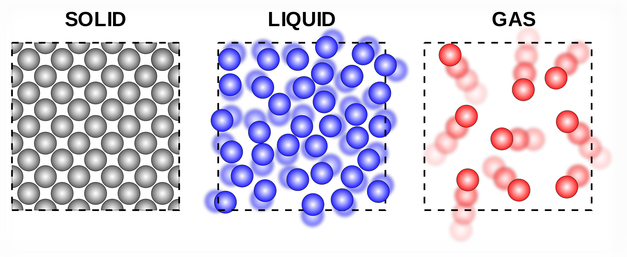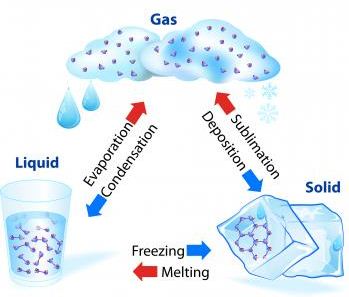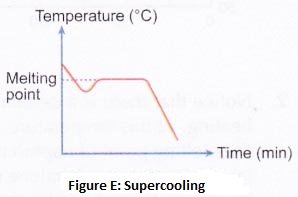What is meant by the Kinetic Theory of Matter?
The Kinetic Theory of Matter:
- The arrangement and movement of particles in solids, liquids and gases are described in the kinetic theory of matter.
- The kinetic theory of matter is used to explain the changes in the states of matter.
- The changes in the states of matter are caused by heating or cooling. For example, ice melts when it is heated and water changes into ice when it is frozen.
- The kinetic energy of particles increases during heating.
- The kinetic energy of particles decreases during cooling.
Arrangement and movement of particles in a gas:
- Arrangement of particles:
The particles are very far apart from each other and are in a random arrangement. - Forces of attraction between particles:
There are weak forces between the particles. Movement of particles The particles can vibrate, rotate and move freely. The rate of collision is greater than the rate of collision in a liquid. - Energy content of particles:
Highest energy content as movement is at random. - Why does a gas not have a fixed shape or volume?
Gas can be easily compressed because the particles have more space between them compared to the particles of liquids or solids. Thus, it has no fixed shape or volume.

Arrangement and movement of particles in a liquid:
- Arrangement of particles:
The particles are packed closely together but not in an orderly arrangement. - Forces of attraction between particles:
The particles are held together by strong forces but weaker than the forces in a solid. - Movement of particles:
The particles can vibrate, rotate and move throughout the liquid. They collide against each other. - Energy content of particles:
Higher energy content as particles can move easily. - A liquid cannot be compressed easily because the particles are packed closely even though are arranged k in disorderly manner. Thus, it has a fixed volume.
- It does not have a fixed shape but takes the shape of the container.
People also ask
- Why does Diffusion take place
- Can Matter Change its State
- What is Matter and what are the Properties of a Solid, Liquid and Gas
Arrangement and movement of particles in a solid:
- Arrangement of particles:
The particles are packed closely together in an orderly manner. - Forces of attraction between particles:
There are strong forces between the particles. - Movement of particles:
The particles can only vibrate and rotate about their fixed positions. - Energy content of particles:
Low energy content as movement is restricted. - Why does a solid have a fixed shape or volume?
A solid cannot be compressed because its particles are very close to one another. Thus, it has a fixed shape or volume.
How can you change matter from one state to another?
Changes in the states of matter:
 Boiling/Evaporation:
Boiling/Evaporation:
- When a liquid is heated, the particles of the liquid gain kinetic energy and move faster as the temperature increases.
- Eventually, the particles have enough energy to completely break the forces holding them together.
- The particles are now able to move freely and far apart.
- A gas is formed. The temperature at which this happens is called the boiling point.
- The boiling point is the temperature at which a liquid changes into A a gas at a particular pressure.
Sublimation:
- Sublimation is a process by which a solid changes directly into a gas without passing through the liquid state.
- Examples of substances that undergo sublimation are iodine, ammonium chloride, NH4Cl and dry ice (solid carbon dioxide).
Freezing:
- When a liquid is cooled, the particles in the liquid lose energy and move slower.
- As the temperature continues to drop, the particles continue to lose more energy until they do not have enough energy to move freely.
- At this point, the liquid changes into a solid.
- The temperature at which this happens is called the freezing point.
- The freezing point is the temperature at which a liquid changes into a solid at a particular pressure.
Condensation:
- When a gas is cooled, the particles in the gas lose energy and move slower.
- As the temperature drops, the gas particles lose energy and M move more slowly.
- Eventually, the movements of the particles become slow enough for the gas to change into a liquid.
- This change occurs at the boiling point of the substance.
Melting:
- When a solid is heated, X the particles in the solid gain kinetic energy and vibrate more vigorously.
- The particles vibrate faster as the temperature increases until the energy they gain is able to overcome the forces, that hold them at their fixed positions.
- At this point, the solid becomes a liquid.
- The temperature at which this happens is called the melting point.
- The melting point is the temperature at which a solid changes into a liquid at a particular pressure.
Melting and Freezing points of Naphthalene Experiment
Aim: To determine the melting and freezing points of naphthalene.
Materials: Naphthalene and tap water.
Apparatus: Boiling tube, 250 cm3 beaker, thermometer, tripod stand, retort stand and clamp, Bunsen burner, stopwatch, conical flask and wire gauze.
Procedure:
A. Heating of naphthalene
- A boiling tube is filled with naphthalene to a depth of 3 cm and a thermometer is put into it.
- The boiling tube is suspended in a beaker half-filled with water using a retort stand and a clamp as shown in Figure A. The level of naphthalene in the boiling tube is ensured to be below the level of water in the beaker.

- The water is heated and the naphthalene (highly flammable) is stirred slowly with the thermometer.
- When the temperature of the naphthalene reaches 60°C, the stopwatch is started. The temperature and the state(s) of the naphthalene are recorded at half-minute intervals until the temperature of the naphthalene reaches 90°C.
B. Cooling of naphthalene
- The boiling tube in section A is removed from the water bath. The outer surface of the boiling tube is dried and immediately it is put in a conical flask, as shown in Figure B. The naphthalene is stirred continuously.

- The temperature and state(s) of the naphthalene are recorded at half¬minute intervals until the temperature drops to about 60°C.
Results:
| Heating of naphthalene | Cooling of naphthalene | ||||
| Time (min) | Temperature (°C) | State | Time (min) | Temperature (°C) | State |
| 0.0 | 61.0 | Solid | 0.0 | 87.0 | Liquid |
| 0.5 | 65.0 | Solid | 0.5 | 84.0 | Liquid |
| 1.0 | 67.0 | Solid | 1.0 | 83.0 | Liquid |
| 1.5 | 71.0 | Solid | 1.5 | 81.0 | Liquid |
| 2.0 | 74.0 | Solid | 2.0 | 80.0 | Liquid and solid |
| 2.5 | 76.0 | Solid | 2.5 | 80.0 | Liquid and solid |
| 3.0 | 79.0 | Solid | 3.0 | 80.0 | Liquid and solid |
| 3.5 | 80.0 | Solid and liquid | 3.5 | 80.0 | Liquid and solid |
| 4.0 | 80.0 | Solid and liquid | 4.0 | 80.0 | Liquid and solid |
| 4.5 | 80.0 | Solid and liquid | 4.5 | 80.0 | Liquid and solid |
| 5.0 | 80.0 | Solid and liquid | 5.0 | 80.0 | Liquid and solid |
| 5.5 | 80.0 | Solid and liquid | 5.5 | 76.0 | Solid |
| 6.0 | 80.0 | Solid and liquid | 6.0 | 73.0 | Solid |
| 6.5 | 83.0 | Liquid | 6.5 | 69.0 | Solid |
| 7.0 | 86.0 | Liquid | 7.0 | 66.0 | Solid |
| 7.5 | 89.0 | liquid | 7.5 | 64.0 | Solid |
Discussion:
- A graph of temperature against time is plotted for the heating of naphthalene, as shown in Figure C.

- Notice that there is a certain part of the curve where there is no change in the temperature with time during heating. At this temperature, both solid and liquid are present. It is the melting point of naphthalene. Hence, the melting point of naphthalene is 80.0°C.
(a) At point A, naphthalene exists as a solid.
(b) When the solid is heated, heat energy is absorbed. This causes the particles to gain kinetic energy and vibrate faster. The temperature increases from point A to point 8.
(c) At point 8, solid naphthalene begins to melt. During the melting process, the temperature of naphthalene does not rise even though heating continues. The temperature remains constant because the heat energy absorbed by the particles is used to overcome the forces between particles so that the solid can turn into a liquid. At this temperature, both solid and liquid are present.
(d) At point C, all the solid naphthalene has melted.
(e) From point C to point D, the particles in liquid naphthalene absorb heat energy and move faster. The temperature increases from point C to point D. - A graph of temperature against time is plotted for the cooling of naphthalene, as shown in Figure D.

- Notice that, there is a certain part of the curve where the temperature is constant with time during the cooling. At this temperature, both solid and liquid are present. It is the freezing point of naphthalene. Hence, the freezing point of naphthalene is 80.0°C.
(a) At point E, naphthalene exists as a liquid.
(b) When the liquid is cooled, the particles in the liquid lose their kinetic energy. They move slower as the temperature decreases from point E to point F.
(c) At point F, liquid naphthalene begins to freeze. During the freezing process, the temperature of naphthalene remains constant because the heat loss to the surroundings is exactly balanced by the heat energy liberated as the particles attract one another to form a solid. At this temperature, both solid and liquid are present.
(d) At point C, all the liquid naphthalene has frozen.
(e) From point C to point H, the particles in solid naphthalene release heat energy and vibrate slower. The temperature decreases from point C to point H. - During the heating of naphthalene,
(a) a water bath is used instead of direct heating with a Bunsen flame. This is to ensure that the naphthalene is
heated evenly. Furthermore, the naphthalene is flammable.
(b) the naphthalene is stirred continuously to ensure an even heating. - During the cooling of naphthalene,
(a) the boiling tube containing liquid naphthalene is placed in a conical flask. This is to ensure an even cooling process and to minimise heat loss to the surroundings.
(b) the naphthalene is stirred continuously to avoid supercooling.
Supercooling is a condition in which the temperature of a cooling liquid drops below its normal freezing point, without the appearance of a solid.

- A water bath is used in this experiment because the melting point of naphthalene is below 100°C, the maximum temperature that can be attained by the water bath. For solids with melting points above 100°C, a liquid with a higher boiling point than water such as oil must be used.
Conclusion:
The melting and freezing points of naphthalene are the same, that is 80.0°C.
